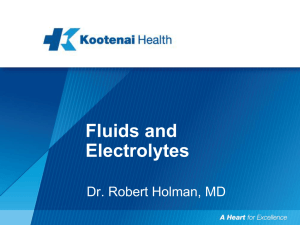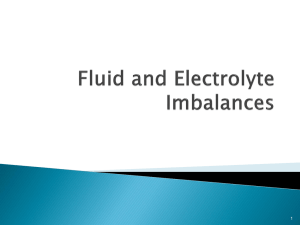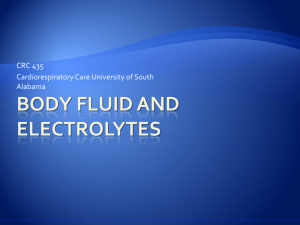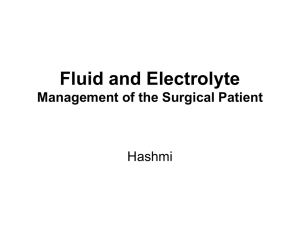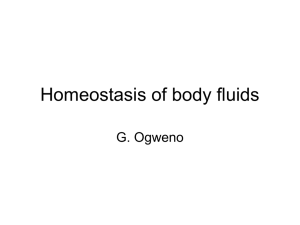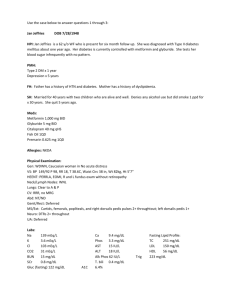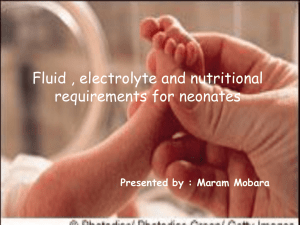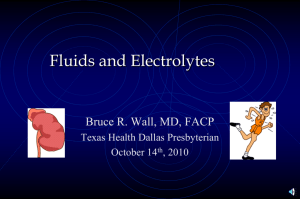disorders of fluid & electrolyte balance
advertisement
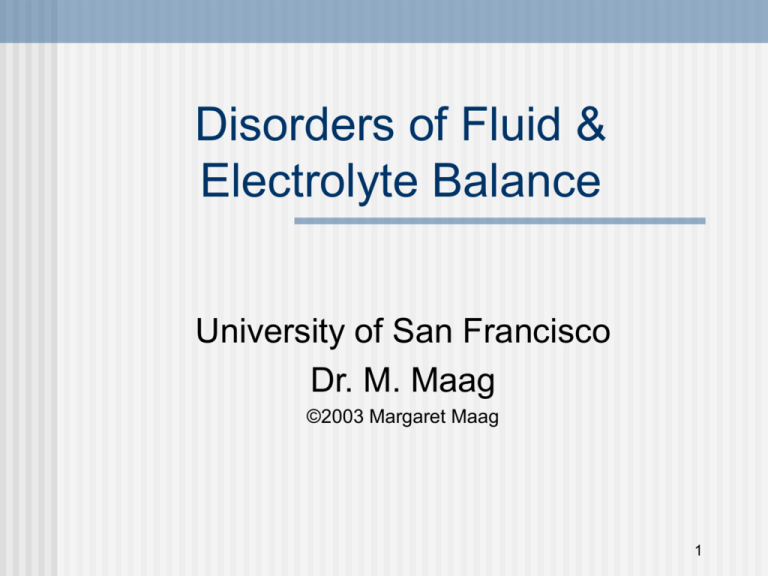
Disorders of Fluid & Electrolyte Balance University of San Francisco Dr. M. Maag ©2003 Margaret Maag 1 Class 6 Objectives Upon completion of this lesson, the student will be able to describe the outcomes associated with hypo and hypervolemia. distinguish between the different etiologies of major electrolyte imbalances. list the manifestations of electrolyte imbalances. identify normal distribution of ICF and ECF. state the normal serum values for Na, K, Cl, Mg, PO4 ,Ca. 2 Starling’s Law of the Capillary Fluids leave (filtration) or enter (re-absorption) the capillaries depending on how the pressure in the capillary and interstitial spaces relate to one another Volume re-absorbed is similar to volume filtered: “A net equilibrium” Regulates relative volumes of blood & interstitial fluid 3 Capillary Exchange The 5% of blood in the systemic capillaries = the bulk of blood that exchanges materials with systemic tissue cells Substances that pass through thin capillary walls into interstitial fluid and then into cells are: nutrients & oxygen Substances that are secreted by tissue cells and removed from them are: wastes & CO2 4 Fluids Distribution of total body water (TBW) 60% of adult body weight is fluid • Gender, body mass & age considerations Intracellular (ICF, within cells = 40% of body weight) Extracellular (ECF, plasma, interstitial & lymph =20% of body weight) 1 Litre water = 2.2lb or 1 kg 5 Developmental Differences Infants & young children Four areas of immature functioning • Increased fluid intake and output relative to size • Total body fluid is 20% more than adults • Greater surface area relative to size: > water loss through skin • Increased metabolic rate up to 2 years • Immature kidney function • requires more fluid to excrete wastes 6 Fluid Shifts “Third Spacing” Excess fluid in interstitial spaces and connective tissues between cells [edema] OR Excess fluid in potential spaces [effusion] • peritoneal cavity • pericardial sac • synovial cavities of joints • alveoli or intra-pleural spaces 7 Fluid Shifts “Third Spacing” Etiology Caused by an increase in filtration and/or decrease in reabsorption due to altered capillary forces Pathophysiology Lymph edema Angioedema Mechanisms causing third spacing & edema massive inflammation venous obstruction increased blood volume low serum albumin 8 Hypovolemia A decrease in the ECF volume Intravascular and interstitial volume Isotonic volume deficit may be due to Decreased intake of isotonic fluids Or excessive • vomiting or diarrhea • hemorrhage • urine output 9 Hypovolemia Hematocrit (Hct) is sensitive to fluid shifts volume (%) of erythrocytes in whole blood 40-54 mL/dL males 37-47 mL/dL females 11.2-16.5 mL/dL children BUN will be elevated d/t < volume 11-23 mg/dL 10 Hypovolemia: manifestations Decreased tissue perfusion Decreased blood volume Check capillary refill time Hypotension, tachycardia, oliguria Tissue dehydration Loss of skin turgor Possible temperature elevation 11 Hypovolemia Nursing Responsibilities: calculate I & O frequently • minimal urinary output = 30cc/hr • check urine specific gravity check O2 saturations draw & analyze blood gases auscultate lungs (side to side) check temperature distal from heart give isotonic solutions (oral or IV) • Normal saline; dextrose, Ringer’s lactate give a fluid bolus as ordered 12 Hypervolemia Excess of isotonic fluid in the intravascular and interstitial spaces Isotonic fluid retention • Olguric state r/t renal failure Secondary Hyperaldosteronism • Inappropriate renal reabsorption of water and sodium,and increased renal secretion of potassium Iatrogenic hypervolemia 13 Hypervolemia Patho An excess in blood volume results in elevated CHP and third spacing Clinical manifestations • • • • Edema Hypertension Bounding pulse Increased urinary output 14 Major Electrolytes Electrolytes Na+, K+, Ca++, Mg+ = cations HCO-3, Cl-, PO-4 = anions ICF = K+ ECF = Na+ osmosis osmolarity capillary dynamics 15 Hyponatremia (Na+ < 135 mEq/L) Low sodium determined by blood chemistry The most common electrolyte imbalance: • 2.5% of hospitalized patients Sodium supports neuron transmission Mechanism and examples Free water gain Deficient sodium intake Renal sodium loss in excess of water Water in excess of sodium gain 16 Hyponatremia (Na+ < 135 mEq/L) Manifestations Water excess rapid weight gain Na+ loss neurological symptoms • irritability, seizures, < LOC Treat water excess Muscle cramps Anorexia/ Nausea/Vomiting (subtle signs) Fluid restriction (I&O) Treat sodium loss • Oral or IV sodium 17 Hypernatremia (Na+ >145 mEq/L) Etiology Water loss or sodium gains Elderly / or comatose patients Na+ intake > water intake Diabetes insipidus (excessive fluid loss) < production of ADH Damage to hypothalamic thirst center? • Tumor or CVA? Manifestations Thirst, dry tongue Restlessness; < LOC; Coma; Intracranial bleeds Weight changes 18 Hypernatremia (Na+ >145 mEq/L) Treatment (Rx) Dilute Na+ and promote secretion Fluids (5% D/W) and diuretics Always check LOC loose alertness & orientation • sepsis, head injury, intracranial bleed Sodium pulls fluid to cause blood vessels to burst 19 Potassium (K+) 3.5-5.0 mEq/L Primarily an intracellular ion; small amount in plasma is essential for normal neuromuscular an cardiac function Maintained by the cellular sodium-potassium pump K+ changes altered excitability of muscles Eliminated by kidneys renal problems causes hyperkalemia Insulin: causes K+ to move from ECF ICF Acidosis, trauma to cells, and exercise • cause K+ to move from ICF ECF: 20 Hyperkalemia K+ > 5.5 mEq/L Major Causes Increased potassium intake • excess or rapid delivery of K+ • penicillin containing K+ • Massive blood transfusion with irradiated packed red cells Buntain and Pabari (1999) Shift of K+ from the ICF to ECF • Acidosis, uncontrolled DM • increased cell lysis (e.g. cytotoxic drugs) Decreased renal excretion • Digitalis toxicity, renal failure, overuse of potassium sparing diuretics (spiroaldactone) 21 Hyperkalemia K+ > 5.5 mEq/L Mainfestations: weak skeletal muscles/ paralysis > 8 mEq/L paresthesias irritability abdominal cramping with diarrhea irregular pulse EKG changes cardiac standstill EKG changes • peaked T-waves and a shortened QT interval occur • Depressed ST segment and widened QRS interval 22 Hyperkalemia K+ > 5.5 mEq/L Management Eliminate K+ Diuretics (Lasix) Dialysis Kayexalate Increased fluids IV insulin Cardiac monitor 23 Hypokalemia K+ < 3.5 mEq Major causes < intake of potassium or > cellular uptake of potassium • Insulin: promotes K+ uptake by muscle & liver cells • When insulin is given: K+ goes into ICF < serum K+ level Uncontrolled diabetes mellitus: • > Glucose: osmotic diuretic > potassium via urinary excretion • Diabetic Ketoacidosis: H+ ions in ECF exchange across cell membranes K+ is first elevated and then K+ stores are excreted via urine 24 Hypokalemia K+ < 3.5 mEq Epinephrine: promotes uptake into cells • stress, acute illness, hypoglycemia Excessive GI loss: diarrhea & ng suction metabolic alkalosis Diuretics: Lasix (watch K+ levels) Excessive renal excretion elevated aldosterone diuresis 25 Hypokalemia K+ < 3.5 mEq Signs & Symptoms Muscle weakness: hypotonia Cardiac dysrhytmias (T-wave inversion or PVCs) Atony of smooth muscle • intestinal distention • constipation • paralytic ileus • urinary retention Confusion or disorientation 26 Hypokalemia K+ < 3.5 mEq Management Administer KCL slowly and accurately dilute properly with other IV fluids • 10 mEqs/1 hour can cause pain and necrosis of veins • use central IV line for large rapid amounts Bring pt out of immediate danger & restore gradually Consider discontinuing diuretic therapy Consider chloride for metabolic alkalosis 27 Calcium 8.8 - 10 mg/dL Major functions: Transmission of nerve impulses Cardiac muscle contractions Blood clotting factor Formation of teeth & bone Muscle contraction Requires: Vitamin D Parathyroid hormone (PTH) Calcitonin from thyroid gland 28 29 http://lpi.oregonstate.edu/infocenter/minerals/calcium/capth.html Hypocalcemia Ca+ < 8.5 mg/dL Nutritional deficiency of calcium or Vitamin D Parathyroid deficiency d/t surgical removal Children & elderly d/t dietary deficiency Bone cancer: excess bone formation “Hungry Tumor” syndrome Treatment of prostrate cancer with estrogen depletes ECF calcium levels Blood transfusions preserve blood with citrate & this binds with calcium 30 Hypocalcemia Ca+ < 8.5 mg/dL Manifestations: Chvostek’s sign Trousseau’s sign Dysrythmias:< threshold for depolarization in cardiac cells Paresthesias: “pins & needles” Abdominal cramping & diarrhea Tetany, Seizures (severe hypocalcemia) 31 Hypercalcemia Ca+ > 10.5 mg/dL Malignancies or hyperparathyroidism PTH secreting tumor (adenoma) Skeletal calcium secreted into bloodstream Metastatic breast cancer & multiple myeloma Prolonged immobility: loose Ca+ from bone into blood Osteoporosis: Ca+ is liberated into bloodstream Manifestations: lethargy/ weakness/fatigue/constipation pathogenic fractures calcium loss from bone 32 Phosphate (PO4 -) 3.0 - 4.5mg/dL or 1.8 - 2.6 mEq/L Stored with Ca+ in bones & teeth PO-4 & Ca+ are equilibrated • > Ca+ = < PO-4 • excreted by kidneys Hypophosphatemia: < 2.7 mg/dL clinical manifestations • confusion, weakness, seizures, numbness, coma Hyperphosphatemia: > 4.5 mg/dL common in renal failure 33 Magnesium (Mg+) 1.5 - 2.5 mEq/L Second most abundant ICF cation Hypermagnesemia: > 2.5mEq/L essential for neuromuscular function changes in serum Mg+ levels effect other electrolytes muscle weakness, bradycardia, hypotension, nausea & vomiting Hypomagnesemia:< 1.5mEq/L increased neuromuscular irritability • Muscle spasms, tetany, seizures 34 References Braxmeyer, D. L. & Keyes, J. L. (1996). The pathophysiology of potassium balance. Critical Care Nurse, 16(5), 59-71. Hansen, M. (1998). Pathophysiology: Foundations of disease and clinical intervention. Philadelphia: Saunders. Huether, S. E., & McCance, K. L. (2002). Pathophysiology. St. Louis: Mosby. 35

